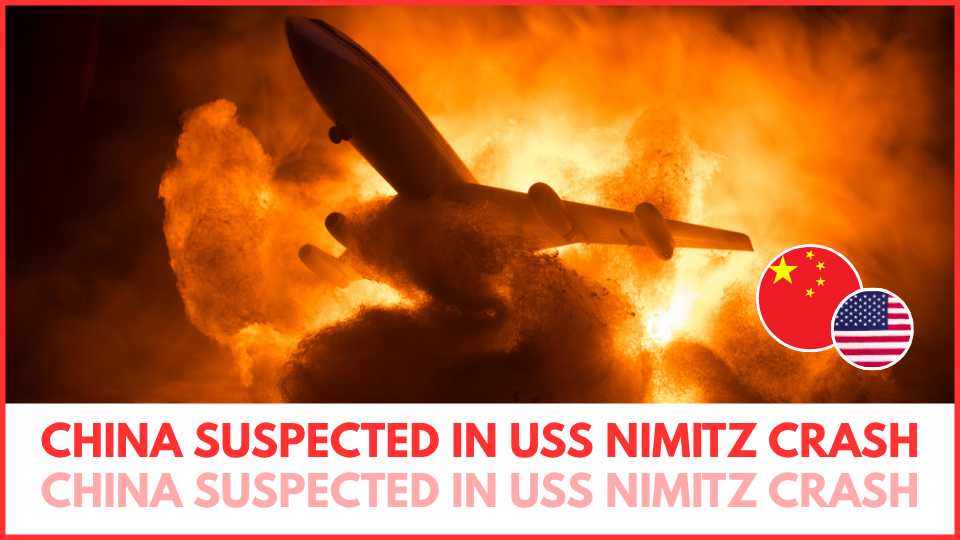China Suspected as US Navy Aircraft from USS Nimitz Crash in South China Sea

South China Sea | October 27, 2025: Two U.S. Navy aircraft — an MH-60R Seahawk helicopter and an F/A-18F Super Hornet fighter jet — have crashed within an hour of each other after taking off from the USS Nimitz, one of America’s oldest and most renowned aircraft carriers currently stationed in the South China Sea.
The U.S. Indo-Pacific Fleet has confirmed that both crashes occurred on Sunday afternoon and has launched an official investigation to determine the cause. The Navy has not ruled out external interference, leading to speculation that China may be involved given the ongoing geopolitical tensions in the region.
Back-to-Back Crashes Spark Mystery
According to official reports, the MH-60R Seahawk from Maritime Strike Squadron 73 (Battlecats) went down at 2:45 PM, followed by the F/A-18F Super Hornet from Strike Fighter Squadron 22 at 3:15 PM. Both aircraft were on separate operations, yet originated from the same carrier.
All five crew members from both aircraft ejected safely and were rescued. However, the rare occurrence of two aircraft crashing within an hour has prompted serious questions within defense circles. Experts say such a coincidence is “highly unlikely” under normal circumstances.
Tensions Escalate in the Indo-Pacific
The South China Sea has long been a flashpoint between the United States and China. Beijing claims nearly the entire region as its own, despite international court rulings favoring the Philippines and other Southeast Asian nations. The U.S. Navy has maintained a strong presence in these waters to ensure freedom of navigation and counter China’s growing military influence.
China continues to construct artificial islands and expand its military bases in the area. Taiwan, meanwhile, has accused Beijing of increased aerial incursions near its airspace, raising fears of a wider conflict. The Nimitz deployment is seen as part of America’s commitment to stability in the Indo-Pacific region.
Timing Raises Political Questions
The incidents coincide with former U.S. President Donald Trump’s ongoing Asian diplomatic tour, which includes a scheduled meeting with Chinese President Xi Jinping. Analysts believe Washington may be deliberately withholding details of the crash to avoid escalating tensions before the talks.
Trade negotiations between the two nations have reportedly shown progress, with discussions focused on tariffs and rare earth mineral exports — materials critical to electric vehicles and semiconductor production.
Pattern of Suspicious Crashes
This is not the first mysterious aviation loss for the U.S. Navy. Earlier this year, two Super Hornet jets went down in the Red Sea under unclear circumstances, sparking speculation about possible missile strikes by Houthi forces. The Pentagon denied the claims, but experts continue to note a recurring pattern of aircraft losses in contested zones.
Aging USS Nimitz Nears Retirement
Commissioned in 1975, the USS Nimitz remains one of the world’s oldest active carriers and is set to be retired next year. Despite its age, it plays a critical role in demonstrating U.S. naval power and deterring aggression in the Indo-Pacific.
Each F/A-18F Super Hornet is valued at approximately $60 million (₹526 crore), making the loss financially significant as well as strategically symbolic.
Growing Global Concern
Analysts warn that this latest incident could further strain U.S.–China relations, particularly amid rising military activity and territorial disputes in the South China Sea. The U.S. Navy’s silence on the exact cause only deepens the mystery — with many questioning whether China’s expanding naval and electronic warfare capabilities are already influencing outcomes at sea.
Editor’s Note: The U.S. Navy investigation remains ongoing, and no official cause has been announced. However, the timing, location, and broader geopolitical backdrop suggest that the South China Sea continues to be one of the world’s most volatile maritime regions — where even a single spark could trigger global consequences.
Frequently Asked Questions (FAQs)
What happened to the USS Nimitz in the South China Sea?
Two U.S. Navy aircraft — an MH-60R Seahawk helicopter and an F/A-18F Super Hornet fighter jet — crashed after taking off from the USS Nimitz while it was operating in the South China Sea. Both incidents occurred within an hour of each other, and the U.S. Navy has launched a formal investigation.
Were there any casualties in the USS Nimitz crash?
No fatalities were reported. All five crew members — three from the Seahawk helicopter and two from the Super Hornet jet — successfully ejected and were rescued by nearby naval teams.
Why is the USS Nimitz crash linked to China?
The crash happened in the South China Sea, a region heavily claimed by China and central to U.S.–China military tensions. Analysts suspect possible interference or electronic disruption, though no official cause has been confirmed. The timing has fueled speculation of rising U.S.–China rivalry in the Indo-Pacific.
What is the significance of the South China Sea?
The South China Sea is one of the world’s busiest and most disputed waterways. China claims nearly the entire region, ignoring international court rulings that favor the Philippines and other nations. The U.S. Navy frequently operates there to ensure freedom of navigation and to counter Beijing’s growing influence.
How old is the USS Nimitz, and what is its current status?
The USS Nimitz was commissioned in 1975 and is one of the world’s oldest active aircraft carriers. It remains a key element of U.S. naval strength but is scheduled for retirement next year after nearly five decades of service.
Has the U.S. experienced similar aircraft crashes recently?
Yes. Earlier this year, two Super Hornet fighter jets crashed in the Red Sea under unclear circumstances. While the U.S. denied any hostile involvement, defense analysts noted a possible pattern of mid-operation aircraft losses in contested regions.
How could this incident impact U.S.–China relations?
The incident may heighten tensions between Washington and Beijing, especially as both nations expand their military presence in the Indo-Pacific. With trade talks and regional disputes already straining ties, the crash adds a new layer of uncertainty to diplomatic relations.
What is the cost of the F/A-18F Super Hornet that crashed?
Each F/A-18F Super Hornet is estimated to cost around $60 million (approximately ₹526 crore), making the loss both financially and strategically significant for the U.S. Navy.
What are experts saying about the USS Nimitz crash?
Military analysts consider it highly unusual for two aircraft to crash from the same carrier within such a short time frame. Some suggest possible electronic interference or cyber disruption, while others believe mechanical failure could be a factor. The ongoing investigation aims to determine the exact cause.
Is the U.S. Navy still operating in the South China Sea after the crash?
Yes. Despite the incident, the U.S. Navy continues its operations in the South China Sea as part of its Indo-Pacific mission to maintain stability, support regional allies, and ensure freedom of navigation in international waters.
